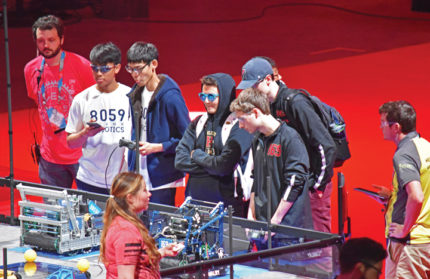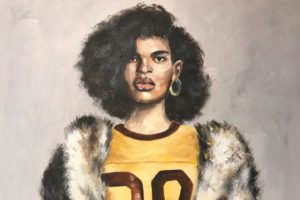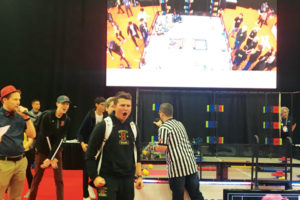Painting, Writing, Science and Robotics You Can’t Imagine the Talent!
Independent School Students Score Awards at National and Regional Contests

Students at our independent and private schools excelled again this past year in academic and creative contests. Several truly outstanding students were recognized with awards, prizes and medals far beyond County Lines country: in regional competitions and national competitions. Some even competed against the world.
Arts and Writing
The Scholastic Art & Writing Awards is an annual national competition with more than 330,000 works entered this year by students around the country. Evaluated on “originality, technical skill and the emergence of personal voice or vision,” the works are judged at the regional level, earning the creators a gold or silver “key.” Gold key recipients are eligible for national medals—gold or silver—with very few winning a Gold Medal.

won a gold medal for her painting, Poofy.
This year, senior Jessica Hao at Episcopal Academy won not one but two medals at the national level for her paintings: Gold for “Poofy” and Silver for “Denim.” She’ll attend University of Pennsylvania to study dentistry, but plans to continue painting.
Sarah Truong, a Linden Hall sophomore, also won a Gold Medal for her Digital Art “Destruction.” Working on a computer, she was moved by global warming, climate change and the destruction of the environment. The canvas is split in two—one side shows beauty, the other environmental destruction.
For expression using the written word, Olivia Cipperman, another Episcopal Academy senior, who plans to study English at Cornell, won a Gold Medal for her “flash fiction” essay called “Selenity.” Her story is very short—less than 500 words—written in a style she calls “economical” and telling a story of “childhood wonder.” One of her two characters is described as a “dreamer.”
Yan Graf, a Haverford School sophomore, scored a Gold Medal for his non-fiction essay, “European Migration: The View from North Africa.” Based on travels with his father in Spain and Morocco, the piece explores the migrants’ predicament where “some swim through dangerous and frigid waters …, others hide themselves in the bottom of cars, and many more attempt to simply storm the wall.” Although young to commit to a career, journalism seems to attract him.
An 8th grader at Jack Barrack Hebrew Academy, Niva Cohen won a Gold Medal for her Critical Essay “CRISPR to the Rescue.” She took a controversial view—though not necessarily her personal view—supporting He Jiankui, the Chinese scientist who used gene editing to prevent the transmission of H.I.V. Arguing that potential benefits “appear to be endless,” she defended the new technology, asserting, “We must rely on ourselves to make ethical decisions …. Right now, we just need to be brave.”
Global Education
The Global Education Benchmark Group prepares students to thrive in increasingly interconnected world systems. The GET Prize—Global Expression and Thought—recognizes students for their learning and growth in the field of global education.
Notre Dame de Namur junior Grace Rivers won the GET Prize this year for her writing. Visiting remote areas of Peru, she wrote of being without cell phone service in an essay titled “No Service.” Rivers’ entry was chosen from among those of high school students around the world.
Science Fair
Founded in 1949 and one of the oldest science fairs in the county, the Delaware Valley Science Fair is sponsored by area companies, foundations, universities and individual donors, with the philosophy that students “learn science by doing science.” This year, several area students were honored.
Gillian Porter, a Bishop Shanahan senior headed to the University of South Carolina this fall, won an award for her work in biochemistry. She was looking for transcription factors suitable for direct reprogramming of cells. Might it cause a secondary disease? She found one factor that would be most suitable and summarized her research in a paper, “Becoming Your Own Organ Donor: Selecting the Most Effective Transcription Factor for Direct Reprogramming.”
Also at Bishop Shanahan, but a junior, Ana Quiñones wondered if she could use a robotic arm to operate a cell phone employing a brainwave monitoring headset made by Emotiv called the EPOC+. Seeing applications to prosthetic limbs, she wanted to send a text message, make a phone call, and take a picture. Her results showed mixed success: phone calls and photos could be done, but not text messaging. Planning to continue with her research, she won the award for biophysics.
Stephen Fratamico, a Malvern Preparatory School senior, won in the behavioral sciences category with a project called “Comparing Rote Memorization to Memorization by Linking Memories to Places.” Linking memory to places—the memory palace technique—requires a person to create images to represent memories and place them in a familiar location. He found this linking technique superior. He’ll attend University of Pennsylvania next year.
Recognizing mathletes, Mu Alpha Theta is a 52-year-old national organization dedicated to scholarship in math. Baiting Zhu of the Westtown School and Rishab Nandan of the Episcopal Academy shared with three others, Mu Alpha Theta’s “Most Challenging, Thorough, and Creative Investigation of a Problem Involving Modern Mathematics” award at the DVSF.
Worlds Robotics
And finally, here’s a big finish in the annual VEX robotics competition, involving about 1,200 teams—winnowed down by local and regional competitions from 24,000 teams in over 60 countries.

The Haverford School entered three teams. One team consisting of three seniors—Wes Clark, the coach, Will Vauclain, the driver, and Scott Shaw, the programmer—finished third in the world. THIRD! Of 1,200 that made it through the local and regional rounds in a competition involving throwing balls at targets. You can see Haverford’s winning robot in action on YouTube.
Starting in the summer of 2018, the team was working 40 or 50 hours per week by December. Just before the World competition in late April 2019, they were pushing more than full-time: anticipating competitors, going over the controls, watching film. It’s “not that different from a regular sport,” says Clark. Clark is headed to Davidson College next year, Vauclain to University of Pennsylvania, and Shaw to Northeastern.
